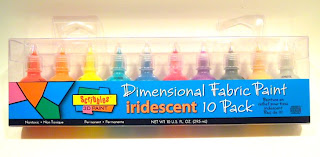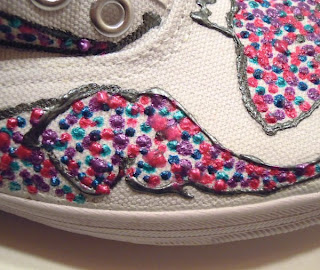Although I've always had an aversion to the look of dimensional fabric paint, I decided to give it a try for today's elephant. However, I've wanted to decorate a pair of sneakers ever since I saw the shoes Susan Shaver decorated in the seventh grade, so I coaxed myself into trying dimensional fabric paint by decorating a pair of sneakers.
I couldn't find any information on what dimensional fabric paint is made of, but I'm assuming it's some kind of acrylic with added plastics or vinyl to make it more viscous, and more able to hold a shape.
I also couldn't find much information on how to use this type of paint, other than things like "squeeze the paint out of the bottle at an angle to make your desired pattern." Apparently, if you squeeze out enough of a blob of paint, you can also set beads and rhinestones into it.
 |
| Most dimensional fabric paint is used for outlining that is later filled in with paint. Source: http://crafts.kaboose.com/shamrock-t-shirt.html |
Although most dimensional fabric paint is used on clothing, some artists use it to decorate metal, plastic and wood, as you can see in the photograph below. I'd never thought of using it for anything other than fabric, but if it's as versatile as all that, I may have to revise my opinion of this particular medium.
 |
| Camera decorated with dimensional fabric paint, by P.J. Linden. Source: http://ilovetocreateblog.blogspot.ca/2010/08/ amazingly-cool-paint-creations-by-pj.html |
For today's elephant, I bought this set of paints from a department store. The whole set cost me about ten dollars.
I also bought a pair of plain white sneakers for five dollars.
I thought it might be a good idea for me to figure out where the elephants would go before I started, so I made a faint pencil sketch on both sneakers. I tried to follow the contours of the shoe, and ended up with six elephants on each: one on the toe, two on each side, and one on the back.
I liked the look of the camera above, so I decided to try making elephants that were filled in with a blend of coloured dots. Before I began, however, I thought I should see how the paints worked. I'm not great with anything that has to be squeezed into a line, so I wasn't terribly confident about this activity. I tend to either make lines so thin that they don't hold together, or I make big ugly blobs.
This was my test strip to give me an idea of the colours.
And this was my little sampler of paint strokes and dots.
I started painting the shoes by outlining all the elephants with the black iridescent paint. Not the prettiest sight I've ever seen, but they'd do as a base. The paint seemed to dry relatively quickly, so there were no smudges at this stage.
Next, I added turquoise dots to each elephant. These also seemed to dry relatively well.
Green came next, followed by purple and pink.
I finished colouring in the elephants by adding orange, then yellow.
This looked pretty, but not quite finished, so I added silver for tusks, and reinforced some of the dark outlines around the ears. I also added new dots for eyes.
I didn't really like all the white space around the elephants, so I decided to pull the design together by sprinkling coloured dots throughout. The ones I added on the tongue were a pain in the neck, because the tongue kept popping up and smearing the paint. In retrospect, I should have taped it down while working on it.
When I added particularly thick paint, as in the tusks, crown and dots, I tried to dry it with a hairdryer. A hairdryer is not really the best tool to dry this type of paint. Because of the amount of vinyl or whatever that the paint contains, the heat of the hairdryer keeps the paint almost liquid. I had much more success in setting the paint when I stuck it on top of one of the air-conditioning vents. A freezer would probably have been even more effective.
When I was finished, my husband asked if these shoes were wearable, or if the paint would fall off or crack. The paint actually seeps quite well into the fabric, and is flexible enough that I don't think it will fall off. I certainly couldn't peel off a couple of errant dots when I tried. (If you do make a mistake, however, I found that rubbing the area with a facecloth soaked in rubbing alcohol removed most of it.)
According to the instructions on the package, the paint needs to set for a minimum of four hours before it's wearable, and can be washed after 72 hours. So I guess if I follow the instructions, the shoes should last quite well.
Now that the trauma of gooey paint is done, I'm quite pleased with the final result. The paint is shimmery, and the play of colours is interesting. I'm not sure how many people would recognize elephants the moment they glanced at my feet, but at least I know they're there.
I never thought I'd like the look of dimensional fabric paint, nor that I'd like working with it. Although I found it a bit tricky to deal with when it was gooey and wet, it's a fairly forgiving medium. It's got a vinyl feel to it that I'm not sure I'd want on a t-shirt, but to decorate shoes or a canvas bag, it's perfect.
Elephant Lore of the Day
In 2003, several scientists assessed the pressure exerted by a stiletto heel worn by the average woman. The weight of the woman, combined with the tiny surface of the heel tip, was expected to create massive localized pressure every time the heel hit the ground.
A couple of researchers took the task even further, comparing the pressure exerted by a stiletto heel with the pressure exerted by an elephant's foot. The question was worded as follows: "What exerts more pressure per square inch when walking: a 100-pound [45-kilogram] woman in high heels, or a 6,000-pound [2,720-kilogram] elephant in bare feet?"
A group of American researchers reported as follows:
Stiletto heels have an area of about 1/16 of a square inch. Elephants, unlike humans, walk with two feet on the ground at a time. Each foot is about 40 square inches. Thus, the woman "wins" by more than 1,500 psi, versus 75 psi, or a difference of more than 10,000 kPa.
A set of British researchers used different parameters:
Sixty-five kilograms on a surface of 2 square centimetres (e.g., high-heeled shoes) will result in a pressure of 3,250,000 Pa beneath the heels, if the person is standing on the surface of Earth. A four-tonne elephant, on the other hand, standing on one foot, will cause a pressure of only 250,000 Pa under the foot, for a difference of 3,000 kPa.
No matter which set of results you use, the conclusion is the same: astonishingly, a woman in high heels exerts at least 20 times the pressure per square inch of an elephant. At 100 pounds, we're also talking about a rather small woman.
Imagine what would happen if anyone ever invents stiletto heels for elephants—and, more importantly, finds a way to induce an elephant to both wear them and walk in them.
 |
| Source: LSNED.com |
To Support Elephant Welfare
Elephant
sanctuaries
(this Wikipedia list allows you to click through to information
on a number of sanctuaries around the
world)




















No comments:
Post a Comment